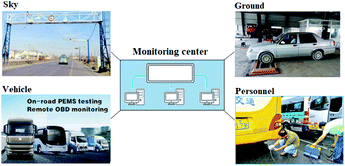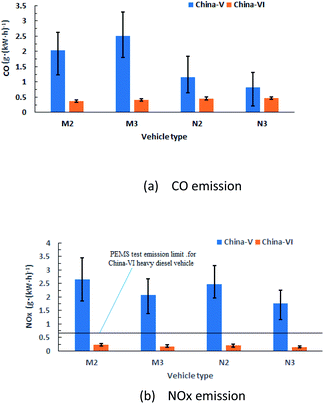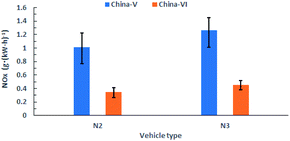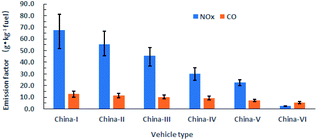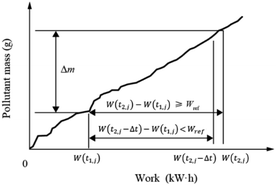 Open Access Article
Open Access ArticleCreative Commons Attribution 3.0 Unported Licence
A multi-pronged approach to strengthen diesel vehicle emission monitoring
Lijun
Hao
 *a,
Hang
Yin
b,
Junfang
Wang
b,
Lanju
Li
c,
Wenhui
Lu
*c,
Haohao
Wang
c,
Yunshan
Ge
a and
Åke
Sjödin
d
*a,
Hang
Yin
b,
Junfang
Wang
b,
Lanju
Li
c,
Wenhui
Lu
*c,
Haohao
Wang
c,
Yunshan
Ge
a and
Åke
Sjödin
d
aSchool of Mechanical Engineering, Beijing Institute of Technology, Beijing 100081, China. E-mail: haolijun@bit.edu.cn
bState Environmental Protection Key Laboratory of Vehicles Emission Control and Simulation, Chinese Research Academy of Environmental Sciences, Beijing, 100012, China. E-mail: yinhang@vecc-mep.org.cn
cWeichai Power Co., Ltd., Weifang 261061, Shandong, China. E-mail: luwh@weichai.com
dIVL Swedish Environmental Research Institute, Stockholm, Sweden
First published on 7th January 2022
Abstract
Vehicle exhaust emissions have become a major source of air pollutants in China, especially from diesel vehicles, which are the main contributors to the total nitrogen oxide (NOx) and particulate matter (PM) emissions from road vehicles. To combat these emissions, China is setting up an integrated vehicle emission monitoring system aiming at organically combining periodic inspections, remote sensing, on-board diagnostics and roadside inspections. Multiple measures, which include vehicle emission in-use compliance tests using portable emission measurement systems (PEMSs), remote OBD monitoring, periodic inspection of NOx emissions and remote emission sensing detection, are taken to monitor the pollutant emissions from diesel vehicles. In this study, all these methods were used to measure the exhaust pollutant emissions of in-use diesel vehicles, to evaluate the trends in real-world emission reductions along with the progress of emission control technologies and emission standards in China.
Environmental significanceDiesel vehicle emissions cause serious environmental pollution, and are monitored by combining remote OBD, periodic inspections, remote sensing and roadside checks in China. Through these methods, the exhaust emissions from diesel vehicles were investigated and analysed. |
Introduction
With the rapid increase in the number of motor vehicles in China, the impact of vehicle emissions on air quality has become increasingly serious. As of the end of 2019, the number of motor vehicles has reached 260 million, among which 18 million vehicles are diesel vehicles which is only about 7% of the total number of motor vehicles. However, the NOx and PM emissions from diesel vehicles make up 80% and 90% of the total NOx and PM emissions from motor vehicles respectively.1Hydrocarbon (HC) and carbon monoxide (CO) emissions from diesel vehicles are very low, while the main concerns of diesel vehicle exhaust pollution are NOx and PM. Nowadays, the particulate emissions from diesel vehicles can be effectively reduced using diesel particulate filters (DPF), while the NOx emissions are more difficult to control, thus diesel vehicles have become one of the main sources of NOx in the atmosphere.2 Previous research shows that although vehicle emission regulations have been substantially tightened, the NOx emissions of diesel vehicles under real driving conditions have not been reduced proportionally.3,4 For diesel vehicles equipped with the selective catalytic reduction (SCR) system, the real driving NOx emissions will significantly increase due to degrading of the SCR catalyst, poor quality of urea or lack of urea. Therefore, effective vehicle emission test methods are needed to monitor the emissions of vehicles in use.
Vehicle exhaust emission test methods mainly include chassis or engine dynamometer tests, vehicle real driving (onboard) emission tests, OBD detection and remote sensing detection. The chassis dynamometer test method is suitable for emission testing of newly produced vehicles and in-use vehicles and has a good repeatability and test stability due to controllable experimental conditions.5–7 However, the chassis dynamometer test is complicated, time consuming and associated with high costs. Further, due to the performance limitation of the dynamometer, it cannot well reflect vehicle actual road emission characteristics.8,9 The vehicle real driving emission test method is to install the portable emission measurement system (PEMS) on the vehicle and connect the vehicle exhaust tailpipe directly to the on-board emission measurement device. Real-time measurements of vehicle emissions under actual driving conditions have great advantages in studying the actual road emission characteristics of vehicles.10–12 Therefore, PEMS testing requirements for vehicle emissions have been incorporated into the emission regulations.13 However, PEMS tests also have the problems of complex equipment and high costs and cannot measure a large number of vehicles in a short period of time. On-board diagnostics (OBD) has emerged along with the development of automobile electronically controlled fuel injection technology. At present, OBD can effectively monitor vehicle emission performance, has good economic benefits and cost advantages.14,15 However, in the short or medium term, OBD cannot replace the vehicle I/M method, because older vehicles are not equipped with OBD systems. The vehicle I/M programs can effectively detect the emissions of in-use vehicles and screen out high-emission vehicles.16 However, since the period of in-use vehicle scheduled inspection is generally more than one year, it cannot be guaranteed that the vehicle can still meet the corresponding emission regulations during the periodic inspection intervals. Remote emission sensing is a convenient vehicle exhaust emission detection technology, which can detect a large number of vehicles in a short time.17–19 The biggest advantage of remote sensing is that it can be used in conjunction with vehicle regular I/M programs to identify high-emitting vehicles, avoid unauthorized adjustments and modifications after regular vehicle inspections, and can detect serious emission control related failures. At present, the trend in China for in-use vehicle emission monitoring is to combine vehicle emission periodic inspection, remote sensing, on-board diagnostics and roadside checks to achieve full coverage of emission monitoring during the vehicle life cycle.
In 2018, Ministry of Ecology and Environment of People's Republic of China (MEEPRC) issued the Action Plan for Tackling the Pollution Control of Diesel Trucks,20 which requires improving the pollution control technology of new vehicles, strengthening the inspection and maintenance (I/M) of in-use vehicles, accelerating the scrapping of old vehicles, strengthening management of non-road mobile pollution sources, and accelerating the use of low-sulfur vehicle fuels.
At present, with the purpose of controlling vehicle emissions effectively, China is now advancing the construction of a motor vehicle emission monitoring system, which is an integrated system aiming at organically combining remote sensing, periodic inspection, on-board diagnostics, PEMS tests and roadside checks. According to the characteristics of the use of these emission detection methods, they are classified into four areas: sky, ground, vehicle and personnel, as shown in Fig. 1.
“Vehicle” represents the new production vehicle emission control technologies, which can effectively control and monitor vehicle emissions after new vehicles are put into use. The China-VI emission standard not only tightens vehicle emission limits, but also puts forward a warranty period request on vehicle emissions, requiring manufacturers to ensure that vehicle emissions meet the standard limits during the vehicle's useful life.21 For heavy-duty diesel vehicles, the remote on-board diagnostics (OBD) is a useful method for real driving emission monitoring. Before the implementation of the China-VI emission standard, some cities such as Beijing required that the remote OBD device must be installed on China-V and earlier heavy-duty diesel vehicles and used to transfer vehicle engine operating parameters and emission data to the vehicle emission monitoring platform in order to effectively monitor heavy-duty diesel vehicle emissions under real driving conditions.22 For the China-VI emission standard, the remote OBD must be installed by the OEM (original equipment manufacturer) and transfer vehicle emission related information continuously to the vehicle emission monitoring center in order to provide real-time and reliable emission information in a timely manner. In addition, considering the difference between emissions from type approval conditions and actual driving conditions, the heavy-duty diesel vehicle emissions are required to be tested by PEMSs under actual road driving conditions after the engine is assembled on the vehicle, and need to meet the corresponding emission limits.21
“Ground” refers to the I/M (inspection/maintenance) programs for in-use vehicles. Although the emission standards for new production vehicles are continuously tightened, after the new vehicles are put into use, their emissions may gradually increase due to the wear and deterioration of vehicle parts. Therefore, the I/M requirement for in-use vehicles is mandatory and very important for ensuring the vehicle emission control system working properly. At present, China is enhancing the compulsory periodic inspections of vehicle emissions across the country. By the end of 2019, there were 8847 in-use vehicle emission inspection agencies nationwide, and a total of 247![[thin space (1/6-em)]](https://www.rsc.org/images/entities/char_2009.gif) 808
808![[thin space (1/6-em)]](https://www.rsc.org/images/entities/char_2009.gif) 800 vehicles participated in regular emission inspections, accounting for 98.1% of the country's vehicle ownership.1 In order to effectively control in-use diesel vehicle NOx emissions, on September 27, 2018, China issued the emission standard “Limits and measurement methods for emissions from diesel vehicles under free acceleration and lug down cycle” (GB 3847-2018),23 which was implemented on May 1, 2019. The standard requires that NOx emissions and exhaust smoke of diesel vehicles to be measured under a lug down test cycle. The NOx emission can be measured by using a chemiluminescence detector (CLD) or a non-dispersive ultraviolet (NDUV) detector. The national unified emission limits of the NOx emission concentration and exhaust smoke opacity are adopted for all diesel vehicles, which are no longer distinguished by the emission stages and vehicle categories. Further, in order to strengthen the supervision and management of the vehicle emission inspection process, the testing agencies must be connected with the environmental protection management department through the internet, the testing process must be conducted online, and the vehicle information and tested emission results must be recorded and stored reliably, and uploaded to the environmental protection management department. The GB 3847-2018 standard also specifies the methods and procedures for visual inspection and OBD inspection of diesel vehicles, and their determination criteria.23
800 vehicles participated in regular emission inspections, accounting for 98.1% of the country's vehicle ownership.1 In order to effectively control in-use diesel vehicle NOx emissions, on September 27, 2018, China issued the emission standard “Limits and measurement methods for emissions from diesel vehicles under free acceleration and lug down cycle” (GB 3847-2018),23 which was implemented on May 1, 2019. The standard requires that NOx emissions and exhaust smoke of diesel vehicles to be measured under a lug down test cycle. The NOx emission can be measured by using a chemiluminescence detector (CLD) or a non-dispersive ultraviolet (NDUV) detector. The national unified emission limits of the NOx emission concentration and exhaust smoke opacity are adopted for all diesel vehicles, which are no longer distinguished by the emission stages and vehicle categories. Further, in order to strengthen the supervision and management of the vehicle emission inspection process, the testing agencies must be connected with the environmental protection management department through the internet, the testing process must be conducted online, and the vehicle information and tested emission results must be recorded and stored reliably, and uploaded to the environmental protection management department. The GB 3847-2018 standard also specifies the methods and procedures for visual inspection and OBD inspection of diesel vehicles, and their determination criteria.23
“Sky” refers to the remote sensing monitoring of vehicle emissions under road driving conditions. Remote sensing, which can measure exhaust emissions of a large sample of on-road vehicles in a short period of time without interrupting traffic, has been used to detect vehicle emissions for more than 30 years,24–26 and has achieved good application results by cooperating with and strengthening the vehicle emission periodic inspections. In order to screen high-emission diesel vehicles, China issued and implemented the first national-level remote-sensing regulation “HJ 845-2017” for measuring exhaust pollutants from diesel vehicles using remote sensing on July 27, 2017. The standard requires to detect NO and smoke emissions from in-use diesel vehicles.27 The remote sensing NO emission limit is 1500 × 10−6 (ppm), which is used to screen high-emission diesel vehicles. China is establishing a vehicle emission remote sensing database and assessing vehicle emission levels through a big data approach in order to provide technical support for vehicle emission management measures at the city level,28 such as vehicle driving restrictions, penalty determination for high emitters, and establishment of low-emission zones or incentive schemes for low emission vehicles.
“Personnel” mainly refers to the roadside inspections and on-site testing of vehicle emissions carried out by vehicle emission inspectors.29 In 2019, environmental protection agencies at all levels strengthened their efforts in inspecting the vehicle emissions. 11![[thin space (1/6-em)]](https://www.rsc.org/images/entities/char_2009.gif) 618
618![[thin space (1/6-em)]](https://www.rsc.org/images/entities/char_2009.gif) 300 vehicles were tested in roadside inspections mainly for exhaust smoke detection, of which 426
300 vehicles were tested in roadside inspections mainly for exhaust smoke detection, of which 426![[thin space (1/6-em)]](https://www.rsc.org/images/entities/char_2009.gif) 400 were found to exceed the emission standards, representing a fraction of 3.7%. Further, a total of 606
400 were found to exceed the emission standards, representing a fraction of 3.7%. Further, a total of 606![[thin space (1/6-em)]](https://www.rsc.org/images/entities/char_2009.gif) 500 vehicles were tested at parking locations, of which 59
500 vehicles were tested at parking locations, of which 59![[thin space (1/6-em)]](https://www.rsc.org/images/entities/char_2009.gif) 100 vehicles were identified as high-emitters, accounting for 9.7% of the total tested vehicles.
100 vehicles were identified as high-emitters, accounting for 9.7% of the total tested vehicles.
At present, China is the first country to adopt remote OBD for heavy-duty diesel vehicle emission monitoring, to test NOx emissions during periodic inspection of in-use diesel vehicles, and to formulate the first national level remote sensing standard for diesel vehicles in the world. China continues to improve its ability to supervise vehicle emissions. The emission testing methods for new production vehicles and in-use vehicles are continuously optimized and the emission limits are also gradually tightened in order to effectively control vehicle emissions throughout their useful life. The vehicle emission test conditions have transitioned from the laboratory to the combination of the laboratory and on the road. The vehicle emission supervision measures cover the type approval tests of new production vehicles, scheduled and roadside inspection tests of in-use vehicles, OBD examination of in-use vehicles and remote sensing detection. Especially for heavy-duty diesel vehicles, in-use compliance emission tests are required after vehicles have been put into use, the remote OBD monitoring system is compulsory to report emission related information to the vehicle emission monitoring platform, NOx exhaust concentrations are measured in the periodic inspection, and remote sensing emission monitoring is used to screen high-emitters. In this study, in order to evaluate the effect of the above emission monitoring measures, the exhaust emissions from diesel vehicles were investigated and analyzed by different methods.
Results and discussion
Heavy-duty diesel vehicle emissions tested using PEMSs
As mentioned previously, control of real driving emissions from in-use diesel vehicles is crucial for controlling air pollution in the transportation sector. In order to investigate the emissions of in-use heavy-duty diesel vehicles, PEMS testing was applied to measure the emissions of in-use heavy-duty diesel vehicles in Beijing. 168 China-V and 76 China-VI heavy-duty diesel vehicles were tested, and the mass emissions of CO and NOx per unit engine power (g (kW h)−1) are statistically analysed based on their different types and different emission levels, and shown in Fig. 2. Table 1 lists the emission limits for heavy-duty diesel vehicles.21,30,31| Emission stage | Test conditions | CO (g (kW h)−1) | NOx (g (kW h)−1) | Emission standard |
|---|---|---|---|---|
| China-V | ETC | 4.0 | 2.0 | GB 17691—2005 |
| PEMS | 6.0 | 4.0 | HJ 857—2017 | |
| China-VI | WHTC | 4.0 | 0.46 | GB 17691—2018 |
| PEMS | 6.0 | 0.69 | GB 17691—2018 |
The CO emissions of China-V and China-VI heavy-duty diesel vehicles can meet the type inspection emission limits and the emission limits for the in-use compliance test using PEMSs. Regarding NOx emissions, although the NOx emissions of China-V M2, M3, and N2 heavy-duty diesel vehicles exceed the type inspection emission limit of the engine test cycle, the NOx emissions of China-V M2, M3, N2, and N3 heavy-duty diesel vehicles all meet the emission limits for in use compliance test with PEMSs, and the NOx emissions of the four types of M2, M3, N2, and N3 China-VI heavy diesel vehicles all meet the vehicle PEMS test emission limit.
Based on on-board emission test results of heavy-duty diesel vehicles in the past ten years, a statistical analysis of the NOx emissions of heavy-duty diesel vehicles at different emission stages is shown in Fig. 3.
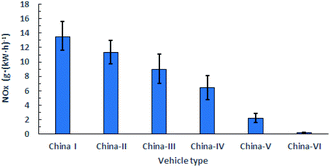 | ||
| Fig. 3 PEMS test results of NOx emissions from heavy-duty diesel vehicles at different emission stages. | ||
Fig. 3 shows that with the continuous tightening of emission standards, the NOx emissions of heavy-duty diesel vehicles have declined significantly. For China-VI heavy-duty diesel vehicles, the PEMS tested NOx emission results can fully meet the emission limits both for the engine and vehicle.
Remote OBD monitoring data of heavy-duty diesel vehicles
Beijing Municipal Environmental Protection Bureau requires that the remote OBD monitoring equipment must be installed on China-V and former heavy-duty diesel vehicles operating in Beijing, so as to monitor the real-time diesel vehicle emissions, and transfer vehicle emission related data to the vehicle emission monitoring center in real time.32 For diesel vehicles not equipped with a NOx sensor from the factory, the OBD remote online monitoring system including the nitrogen oxygen sensor must be installed to monitor the emissions of heavy duty diesel vehicles in real time, and transfer to the monitoring platform the required information including vehicle position, NOx emission, urea level, engine coolant temperature, engine fuel flow, vehicle speed, engine speed, fault indicator status, the percentage of actual engine torque, engine reference torque, atmospheric pressure, etc. The remote OBD system must be monitored using the anti-tampering system in order to find removal or deactivation of any sensor that prevents it from diagnosing the failures in the emission control system.For the China-VI emission standard, all China-VI heavy-duty diesel vehicles must be connected to the monitoring center using an on-board remote OBD system through the internet.21 At the current stage, the vehicle emission related data are uploaded to the enterprise monitoring platform, which is responsible for collecting, processing and storing the vehicle emission data, and transferring the data to the vehicle emission monitoring center established by the local ecological environment departments at all levels.
Based on the NOx sensor data and other related information of 315 China-VI and 2380 China-V heavy-duty diesel vehicles transferred by the remote OBD system during actual road driving, the specific NOx emission results of heavy-duty diesel vehicles were statistically analysed and shown in Fig. 4. It can be seen that the average NOx emission test results of the N2 and N3 heavy-duty diesel vehicles equipped with the remote OBD monitoring system did not exceed the emission limits and the OBD limits during actual road operation.
Exhaust emissions from in-use diesel vehicles over the lug down test cycle
The NOx and PM emissions of diesel vehicles typically increase with the engine load, so the diesel vehicle emission periodic inspection, which is called the lug down test, is performed on a chassis dynamometer at the maximum power output of the driving wheel. For in-use diesel vehicles, exhaust smoke opacity is detected to characterize PM emissions. Table 2 shows the NOx and exhaust smoke emission limits for the periodical inspection of in-use diesel vehicles.23| Test method | NOx (10−6) | Exhaust smoke opacity (m−1) | ||
|---|---|---|---|---|
| Limit A | Limit B | Limit A | Limit B | |
| a Limit A applies to the in-use diesel vehicles nationwide, and limit B applies to the in-use diesel vehicles used in low-emission zones. | ||||
| Lug down test | 1500 | 900 | 1.2 | 0.7 |
In this paper, the NOx emission and exhaust smoke opacity data of diesel vehicles tested over the lug down cycle in Beijing are statistically analysed to investigate the emission status of diesel vehicles in Beijing. The probability distribution and cumulative distribution probability of the NOx emission concentrations and exhaust smoke opacity data tested over the lug down cycle are shown in Fig. 5.
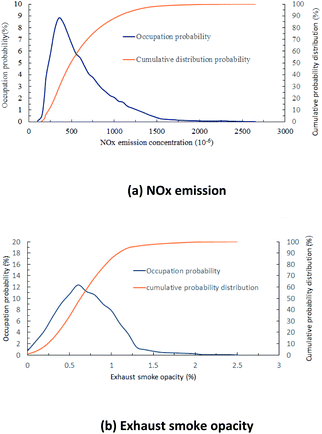 | ||
| Fig. 5 Probability distribution and cumulative probability distribution of the diesel vehicle NOx emission concentrations and exhaust smoke opacities in the lug down tests. | ||
Fig. 5 shows that only 1.8% of in-use diesel vehicles exceed NOx emission limit A, and about 5.5% of in-use diesel vehicles exceed exhaust smoke limit A during periodic inspection in Beijing.
The China-V emission standard for new production diesel vehicles was implemented nationwide since July 1, 2017. The emission limits for in-use diesel vehicles specified in Table 3 are determined based on the vehicle type composition and emission status of in-use diesel vehicles nationwide before 2018. At that time, China-III and earlier stage diesel vehicles still accounted for a high proportion of the total diesel vehicles nationwide. Compared with the national timetable, Beijing implemented the China-V emission standard since June 1, 2015, two years ahead of the whole country. At present, China-III and earlier emission stage diesel vehicles in Beijing have almost been eliminated, and most of the in-use diesel vehicles are compliant with China-IV and China-V emission standards. According to Fig. 5a, 83.8% of in-use diesel vehicles can meet NOx emission limit B. Since the China-VI emission standard has been implemented nationwide, more and more China-VI diesel vehicles will replace the old ones, therefore, the NOx emission limit B should be considered to be applied for in-use diesel vehicles in Beijing.
| Vehicle type | Composition ratios of different road types | ||
|---|---|---|---|
| Urban road (vehicle speed < 60 km h−1) | Suburban road (60 km h−1 < vehicle speed < 90 km h−1) | Motorway (vehicle speed > 90 km h−1) | |
| M1\N1 | 34% | 33% | 33% |
| M2\M3\N2 (except for urban vehicles) | 45% | 25% | 30% |
| N3 (except for urban vehicles) | 20% | 25% | 55% |
| Urban vehicles (buses, distribution vehicles) | 70% | 30% | — |
Remote sensing emissions of in-use diesel vehicles
Remote sensing has been proven effective in measuring the exhaust pollutant concentration emissions from gasoline and liquefied petroleum gas (LPG) vehicles.33,34 And the inversion calculation method of absolute exhaust concentration emissions from diesel vehicles has also been investigated and is being optimized and validated by further research.35 The measurement of vehicle tailpipe pollutant concentrations can be more easily used to screen high emission vehicles or to detect the malfunctions of the vehicle exhaust after-treatment system, and can be compared with the tailpipe emissions that are measured during the vehicle periodical inspection and maintenance process.Although remote sensing typically measures a short time snapshot of vehicle emissions, the standardized remote sensing emission data can be used for evaluating the in-use vehicle emission level. For this purpose, the fuel-specific emission factors of CO, HC and NO can be calculated based on the concentration ratios of NO, CO, HC to CO2 in the exhaust plume, and they can perfectly indicate how many pollutants are created per unit mass of fuel burned and can be used to calculate vehicle emissions and compile vehicle emission inventories.36,37
Based on the remote sensing detection data of heavy-duty diesel vehicles in the past ten years, the CO and NO emission factors (g kg−1 fuel) of heavy-duty diesel vehicles compliant with China I, China-II, China-II, China-IV, China-V and China-VI were statistically analysed and shown in Fig. 6.
As shown in Fig. 6, the CO emissions of heavy-duty diesel vehicles at each emission stage are relatively low and stable, while the fuel-based NOx emission factors of heavy-duty diesel vehicles show a decreased tendency with the tightened emission standards. Especially, the NOx emissions of China-VI heavy-duty diesel vehicles are much lower than other emission stage counterparts due to the improved emission control technologies.38,39
The vehicle emission information obtained from the above detection methods needs to be reported to the vehicle emission monitoring center online, which greatly improves the ability and efficiency of vehicle emission supervision. In this paper, the exhaust pollutant emissions of diesel vehicles are investigated and evaluated by different methods and proved to be significantly reduced.
The emission test methods for new production vehicles and in-use vehicles are continuously improved and the emission limits are also gradually tightened in order to control vehicle emissions throughout their usage time. With the gradual phase-out of China-III light-duty vehicles, China-IV heavy-duty diesel vehicles and previous vehicles, all vehicles will be equipped with OBD systems. The OBD system, especially remote OBD for heavy-duty diesel vehicles, can effectively monitor the malfunctions related to vehicle emissions, supplemented by vehicle annual inspection and vehicle emission remote sensing, and can prevent air pollution from vehicle emissions.
Materials and methods
Heavy-duty diesel vehicle emission testing and data processing methods using PEMSs
According to the emission regulations, vehicle emission test routes include urban road, suburban road and highway for real driving emission test using PEMSs.21 And based on the vehicle type, the required composition of different road types is defined in specified ratios, which are shown in Table 3, and allowed to have a deviation of ±5%.The entire RDE test should be carried out continuously for 90–120 min; the altitude difference between the starting point and the end point for the entire journey cannot exceed 100 m, and the cumulative positive altitude increase of the total travel route for the test vehicle shall not exceed 1200 m per 100 km.
The processing of PEMS tested emission data for the heavy-duty diesel vehicles is based on the work-based window method, which divides the tested emission data during the entire journey into different subsets based on the power that the engine produces on the test bench over the ETC or WHTC cycle. The China-V and China-VI heavy-duty diesel vehicles use ETC cycle power and WHTC cycle power to determine the window size respectively. These subsets are called moving average windows, and the emission data calculation within the moving average window is performed at a frequency of 1 Hz. The formula for calculating the instantaneous mass emission rate of gaseous exhaust pollutants is described as
ṁi = ρi × Ci × ![[Q with combining dot above]](https://www.rsc.org/images/entities/i_char_0051_0307.gif) e × 10−3 e × 10−3 | (1) |
![[Q with combining dot above]](https://www.rsc.org/images/entities/i_char_0051_0307.gif) e is the measured instantaneous exhaust volume flow rate [m3 s−1]; Ci is the concentration of exhaust pollutant “i” in the exhaust [10−6]; and ρi is the density of exhaust pollutant “i” [kg m−3].
e is the measured instantaneous exhaust volume flow rate [m3 s−1]; Ci is the concentration of exhaust pollutant “i” in the exhaust [10−6]; and ρi is the density of exhaust pollutant “i” [kg m−3].
It should be noted that all the pollutants involved in the calculations above need to be corrected to the standard state of 273 K and 101.3 kPa before calculations.
Then, the instantaneous power of the engine is calculated based on the engine torque and engine speed provided by the engine electronic control unit (ECU):
 | (2) |
Therefore, the cumulative engine work from time 0 to time t can be expressed as
 | (3) |
As shown in Fig. 7, the engine work of the j-th moving average window, which is defined from t2,j to t1,j, needs to meet
| W(t2,j) − W(t1,j) ≥ Wref | (4) |
t 2,j is selected and determined from formula (5):
| W(t2,j − Δt) − W(t1,j) < Wref ≤ W(t2,j) − W(t1,j) | (5) |
The total mass emission of each pollutant within the j-th window can be calculated from:
 | (6) |
The specific mass emission of each pollutant i within the j-th window can be calculated using formula (7):
 | (7) |
For the type inspection of heavy duty diesel vehicles, if emissions within 90% or more of the valid windows meet the emission limits for RDE, the diesel vehicle is judged to be emission qualified. However, the main purpose of this paper is to evaluate the diesel vehicle emission performance, therefore, the vehicle specific emissions during the entire trip are calculated as follows:
 | (8) |
Remote OBD monitoring of heavy-duty diesel vehicle emissions
Nowadays, vehicle emissions are the prime air pollution source in Beijing, therefore the China-V heavy-duty diesel vehicles registered in Beijing are required to install remote OBD monitoring terminals, which are used to transmit the vehicle emission related data to the vehicle emission monitoring platform so as to realize real-time monitoring and normalized tracking of the heavy-duty diesel vehicle operating conditions and pollutant emission information.40 In addition, large amounts of heavy-duty diesel vehicle emission data can be analyzed by using the big data method to screen high emission vehicles, evaluate vehicle emissions and build vehicle emission inventories. And remote monitoring of the heavy-duty diesel vehicle emissions also provides a reliable scientific basis for environmental management and macroeconomic decision-making in a timely manner.Based on the received remote OBD information, the emission factor of pollutant i per unit work of the engine during the vehicle driving period from t1 to t2 can be calculated from
 | (9) |
Furthermore, the emission factor of pollutant i per unit distance travelled during the period from t1 to t2 can be calculated from
 | (10) |
Periodic inspection of exhaust emissions from in-use diesel vehicles
In the world, the current periodic inspections for in-use diesel vehicles mainly focus on the exhaust smoke, which indirectly reflects the PM emission. Almost no country tests the NOx emission of in-use diesel vehicles during the annual inspection. In order to control the diesel vehicle NOx emission, the emission standard GB 3847-2018 requires measuring NOx emissions in the lug down test since May 1, 2019.Generally, diesel engines produce more NOx and PM under high load conditions, therefore, the periodic inspection of the NOx concentration is performed with the fully pressed vehicle accelerator pedal. The optical absorption coefficient (k) of the diesel vehicle exhaust gas is measured under the condition of maximum wheel power (VelMaxHP), which is the maximum mechanical energy produced by the drive wheel according to the test procedure defined in the emission standard. The NOx concentration is only measured under the full load with a speed which is 80% of the maximum speed of VelMaxHP, while the optical absorption coefficient (k) of the diesel vehicle exhaust gas is measured.23
Detection of diesel vehicle emissions by remote sensing
Remote sensing can be used to measure the exhaust concentration emissions from diesel vehicles, and the inversion calculation method of the absolute concentration of CO2 emission from diesel vehicles can be expressed as35 | (11) |
Then, the absolute tailpipe emission concentrations of CO, HC and NO from diesel vehicles can be calculated from
| CCO = CCO2ØCO | (12) |
| CHC = CCO2ØHC | (13) |
| CNO = CCO2ØNO | (14) |
The remote sensing measured tailpipe emission concentration can be used to screen high emission vehicles, and is comparable with the tailpipe emissions measured during periodical inspection. But for vehicle emission remote sensing, the instantaneous vehicle exhaust flow is usually difficult to measure; therefore, the absolute mass emissions of the vehicle exhaust pollutants can hardly be calculated. As an alternative, the fuel-based emission factors of CO, HC and NO (g kg−1 fuel) can be calculated based on the concentration ratios of CO, HC and NO to CO2, as well as the molecular weights of different components. The fuel-based emission factors can be used to evaluate the vehicle emission level.
The fuel-based emission factors of CO, HC and NO can be calculated from the equation:41
 | (15) |
Conclusions and future perspectives
In order to monitor vehicle exhaust pollution, the integrated vehicle emission monitoring system composed of sky, ground, vehicle and personnel has been set up in China, and vehicle emission supervision covers all aspects of vehicle use including new vehicle type test, vehicle in-use compliance test, periodic inspection of in-use vehicles, roadside spot check and remote sensing. Especially for heavy-duty diesel vehicles, remote OBD monitoring and periodic inspection of NOx emissions are compulsory. The vehicle emission information obtained from all these detection methods are reported to the vehicle emission monitoring center online, which greatly improves the ability and efficiency of vehicle emission supervision. In this paper, the exhaust pollutant emissions of diesel vehicles are investigated and evaluated by different methods and proved to be significantly reduced. In this study, the exhaust emissions of heavy-duty diesel vehicles were investigated and evaluated by different methods, and the results show the trend of emission reduction with the progress of emission control technology and emission standards for heavy-duty diesel vehicles.The emission test methods for new production vehicles and in-use vehicles are continuously improved and the emission limits are also gradually tightened in order to control vehicle emissions throughout their usage time. With the gradual phase-out of China-III light-duty vehicles and China-IV and earlier heavy-duty diesel vehicles, all vehicles will be equipped with OBD systems. The OBD system, especially remote OBD for heavy-duty diesel vehicles, can effectively monitor the malfunctions related to vehicle emissions, supplemented by vehicle annual inspection and vehicle emission remote sensing, and can effectively prevent air pollution from vehicle emissions.
Author contributions
Lijun Hao: conceptualization, methodology, investigation, writing original draft and revising.Hang Yin: conceptualization, methodology and formal analysis.
Junfang Wang: methodology, resources and validation.
Lanju Li: methodology, investigation and validation.
Wenhui Lu: resources, investigation and validation.
Haohao Wang: investigation, formal analysis and validation.
Yunshan Ge: project administration, conceptualization and methodology.
Åke Sjödin: conceptualization, writing – review & editing and revising.
Conflicts of interest
The authors declare no conflicts to declare.Acknowledgements
This work was funded and supported by National Key R&D Plan [2018YFE0106800-001] and Research Funding from Weichai Power Co., Ltd.Notes and references
- Ministry of Ecology and Environment of the People's Republic of China (MEEPRC), China Mobile Source Environmental Management Annual Report, Beijing (in Chinese), 2020 Search PubMed.
- S. C. Anenberg, et al., Impacts and mitigation of excess diesel-related NOx emissions in 11 major vehicle markets, Nature, 2017, 545, 467–471 CrossRef CAS PubMed.
- D. C. Carslaw, S. D. Beevers, J. E. Tate, E. J. Westmoreland and M. L. Williams, Recent evidence concerning higher NOx emissions from passenger cars and light duty vehicles, Atmos. Environ., 2011, 45(39), 7053–7063 CrossRef CAS.
- Y. Wu, S. Zhang, J. Hao, H. Liu, X. Wu, J. Hu, M. P. Walsh, T. J. Wallington, K. M. Zhang and S. Stevanovic, On-road vehicle emissions and their control in China: a review and outlook, Sci. Total Environ., 2017, 574, 332–349 CrossRef CAS PubMed.
- S. Jung, J. Lim, S. Kwon, S. Jeon, J. Kim and J. Lee, et al., Characterization of particulate matter from diesel passenger cars tested on chassis dynamometers, J. Environ. Sci., 2017, 54, 21–32, DOI:10.1016/j.jes.2016.01.035.
- L. Chen, Z. Wang, S. Liu and L. Qu, Using a chassis dynamometer to determine the influencing factors for the emissions of Euro VI vehicles, Transp. Res. D, Transp. Environ., 2018, 65, 564–573, DOI:10.1016/j.trd.2018.09.022.
- C. A. Alves, D. J. Lopes, A. I. Calvo, M. Evtyugina, S. Rocha and T. Nunes, Emissions from light-duty diesel and gasoline in-use vehicles measured on chassis dynamometer test-cycles, Aerosol Air Qual. Res., 2015, 15(1), 99–116, DOI:10.4209/aaqr.2014.01.0006.
- P. Dixit, J. W. Miller, D. R. Cocker III, A. Oshinuga, Y. Jiang, T. D. Durbin and K. C. Johnson, Differences between emissions measured in urban driving and certification testing of heavy-duty diesel engines, Atmos. Environ., 2017, 166, 276–285, DOI:10.1016/j.atmosenv.2017.06.037.
- L. Pelkmans and P. Debal, Comparison of on-road emissions with emissions measured on chassis dynamometer test-cycles, Transp. Res. D, Transp. Environ., 2006, 11, 233–241, DOI:10.1016/j.trd.2006.04.001.
- H. C. Frey, A. Unal, N. M. Rouphail and J. D. Colyar, On-road measurement of vehicle tailpipe emissions using a portable instrument, J. Air Waste Manage. Assoc., 2003, 53(8), 992–1002, DOI:10.1080/10473289.2003.10466245.
- S. Kwon, Y. Park, J. Park, J. Kim, K. Choi and J. Cha, Characteristics of on-road NOx emissions from Euro 6 light-duty diesel vehicles using a portable emissions measurement system, Sci. Total Environ., 2017, 576, 70–77, DOI:10.1016/j.scitotenv.2016.10.101.
- B. Daham, H. Li, G. Andrews, K. Tate J Ropkins and M. C. Bell, Driver variability influences on real-world emissions at a road junction using a PEMS, SAE Technical Paper, 2010, DOI:10.4271/2010-01-1072. Paper No.:2010-01-1072.
- M. Williams and R. Minjares, A technical summary of Euro 6/VI vehicle emission standards, The International Council on Clean Transportation (ICCT), 2016, https://theicct.org/sites/default/files/publications/ICCT_Euro6-VI_briefing_june.2016.pdf/, accessed 5 August 2019 Search PubMed.
- G. Chamarthi, A. Sarkar, P. Baltusis and M. Laleman, Comprehensive Diagnostic Methodology, SAE Technical Paper 2017-01-1685, 2017, DOI:10.4271/2017-01-1685.
- M. Farrugia, J. P. Azzopardi, E. Xuereb, C. Caruana and M. Farrugia and, The usefulness of diesel vehicle onboard diagnostics (OBD) information, 2016 17th International Conference on Mechatronics – Mechatronika (ME), 2016, pp. 1–5 Search PubMed.
- D. S. Eisinger and P. Wathern, Policy evolution and clean air: the case of US motor vehicle inspection and maintenance, Transp. Res. D, Transp. Environ., 2008, 13, 359–368, DOI:10.1016/j.trd.2008.05.001.
- K. Ropkins, T. H. DeFries, F. Pope, D. C. Green, J. Kemper and S. Kishan, et al., Evaluation of EDAR vehicle emissions remote sensing technology, Sci. Total Environ., 2017, 609, 1464–1474, DOI:10.1016/j.scitotenv.2017.07.137.
- R. Smit and P. Kingston, Measuring on-road vehicle emissions with multiple instruments including remote sensing, Atmosphere, 2019, 10, 516, DOI:10.3390/atmos10090516.
- Å. Sjödin and K. Andréasson, Multi-year remote-sensing measurements of gasoline light-duty vehicle emissions on a freeway ramp, Atmos. Environ., 2000, 34, 4657–4665 CrossRef.
- Ministry of Ecology and Environment of People's Republic of China (MEEPRC), Action Plan for Tackling the Pollution Control of Diesel Trucks, 2018, No. 179, http://www.mee.gov.cn/xxgk2018/xxgk/xxgk03/201901/W020190104656772362578.pdf Search PubMed.
- Ministry of Ecology and Environment of People's Republic of China (MEEPRC), Limits and measurement methods for emissions from diesel fueled heavy-duty vehicles (CHINA VI) (GB 17691-2018), Beijing (in Chinese), 2018 Search PubMed.
- Beijing Municipal Bureau of Ecology and Environment (BMBEE), Announcement of the Beijing Municipal Bureau of Ecology and Environment on the issuance of the “Administrative Measures for the Installation of Vehicle-mounted Terminals for the Remote Monitoring and Management of Emissions from Heavy-duty Vehicles and Non-road Mobile Machinery in Beijing (Trial)”, beijing.gov.cn, 2020, http://sthjj.beijing.gov.cn/bjhrb/index/xxgk69/zfxxgk43/fdzdgknr2/shbjgfxwj/1792143/index.html Search PubMed.
- Ministry of Ecology and Environment of People's Republic of China (MEEPRC), Limits and measurement methods for emissions from diesel vehicles under free acceleration and lugdown cycle (GB 3847-2018), Beijing (in Chinese), 2018 Search PubMed.
- G. A. Bishop, J. R. Starkey and A. Ihlenfeldt, et al., IR long-path photometry: a remote sensing tool for automobile emissions, Anal. Chem., 1989, 61, 671A–677A CrossRef CAS PubMed.
- T. L. Chan, Z. Ning, C. W. Leung, C. S. Cheung, W. T. Hung and G. Dong, On-road remote sensing of petrol vehicle emissions measurement and emission factors estimation in Hong Kong, Atmos. Environ., 2004, 38, 2055–2066 CrossRef CAS.
- S. K. Grange, N. J. Farren, A. R. Vaughan, J. Davison and D. C. Carslaw, Post-Dieselgate: Evidence of NOx Emission Reductions Using On-Road Remote Sensing, Environ. Sci. Technol. Lett., 2020, 7, 382–387 CrossRef CAS PubMed.
- Ministry of Ecology and Environment of the People’s Republic of China (MEEPRC), Measurement method and specifications for exhaust pollutants from in-use diesel vehicles by remote sensing method (HJ 845-2017), Beijing (in Chinese), 2017 Search PubMed.
- L. Hao, H. Yin and J. Wang, et al., Potential of big data approach for remote sensing of vehicle exhaust emissions, Sci. Rep., 2021, 11, 5472, DOI:10.1038/s41598-021-84890-7.
- G. Li, J. Wang and Y. Ding, Progress, Problems and Suggestions on Treatment of Pollution Caused by Diesel Trucks, China Environmental Protection Industry, 2020, issue 11, pp. 19–23, in Chinese Search PubMed.
- Ministry of Ecology and Environment of People's Republic of China (MEEPRC), Limits and measurement methods for exhaust pollutants from compression ignition and gas fueled positive ignition engines of vehicles (III, IV, V) (GB 17691-2005), Beijing (in Chinese), 2005 Search PubMed.
- Ministry of Ecology and Environment of People's Republic of China (MEEPRC), Measurement method and technical specification for PEMS test of exhaust pollutants from heavy-duty diesel and gas fueled vehicles (HJ 857-2017), Beijing (in Chinese), 2017 Search PubMed.
- Beijing Municipal Ecological Environment Bureau (BJEEB), Limits and Measurement Method of Emissions from Heavy-Duty Vehicle (OBD Method Phase IV and V) (DB11/1475-2017), Beijing (in Chinese), 2017 Search PubMed.
- Z. Ning and T. L. Chan, On-road remote sensing of liquefied petroleum gas (LPG) vehicle emissions measurement and emission factors estimation, Atmos. Environ., 2007, 41, 9099–9110 CrossRef CAS.
- Y. Huang, B. Organ and J. L. Zhou, et al., Remote sensing of on-road vehicle emissions: mechanism, applications and a case study from Hong Kong, Atmos. Environ., 2018, 182, 58–74 CrossRef CAS.
- L. Hao, H. Yin, J. Wang, X. Wang and Y. Ge, Remote sensing of NO emission from light-duty diesel vehicle, Atmos. Environ., 2020, 242, 117799, DOI:10.1016/j.atmosenv.2020.117799.
- I. Schifter, L. Diaz, V. Mugica and E. Lopez-Salinas, Fuel-based motor vehicle emission inventory for the metropolitan area of Mexico City, Atmos. Environ., 2005, 39, 931–940 CrossRef CAS.
- T. Lee and H. C. Frey, Evaluation of representativeness of site-specific fuel-based vehicle emission factors for route average emissions, Environ. Sci. Technol., 2012, 46(12), 6867–6873 CrossRef CAS PubMed.
- L. Wang, Z. Weng and H. Tian, Development of asymmetrical turbocharger for heavy duty vehicle diesel engine complying with china VI emission regulations, Automob. Technol., 2017,(9), 44–47 Search PubMed.
- G. Theodoros, F. Georgios, G. Barouch and Z. Nikiforos, Real world emissions performance of heavy-duty Euro VI diesel vehicles, Atmos. Environ., 2019, 201, 348–359, DOI:10.1016/j.atmosenv.2018.12.042.
- Announcement of the Beijing Municipal Bureau of Ecology and Environment on the issuance of the “Administrative Measures for the Installation of Vehicle-mounted Terminals for the Remote Monitoring and Management of Emissions from Heavy-duty Vehicles and Non-road Mobile Machinery in Beijing (Trial)”, beijing.gov.cn, http://sthjj.beijing.gov.cn/bjhrb/index/xxgk69/zfxxgk43/fdzdgknr2/shbjgfxwj/1792143/index.html Search PubMed.
- Y. Huang, N. C. Surawski and Y. Yam, et al., Re-evaluating effectiveness of vehicle emission control programmes targeting high-emitters, Nat. Sustain., 2020,(3), 904–907, DOI:10.1038/s41893-020-0573-y.
| This journal is © The Royal Society of Chemistry 2022 |

